FRANCE
Dijon

Dijon
Dijon
Dijon is the capital of the Côte-d'Or department and also the historic capital of Burgundy. According to the 2008 census, there are 151,576 residents living within the city limits and 250,516 in the metropolitan area.
Dijon is a commercial, industrial, transport and educational center. The University of Bourgogne dates back to 1722. The city is known all over the world for its mustard and excellent wines. An international gastronomic fair with more than 500 exhibitors and 200,000 visitors is held in Dijon every year. It is one of the top ten fairs in France.
Gustave Eiffel, prominent builder of the Eiffel Tower, was born in Dijon in 1832. The city has become a renowned tourist center for its rich architectural heritage, excellent museums, festivals and attractive events.
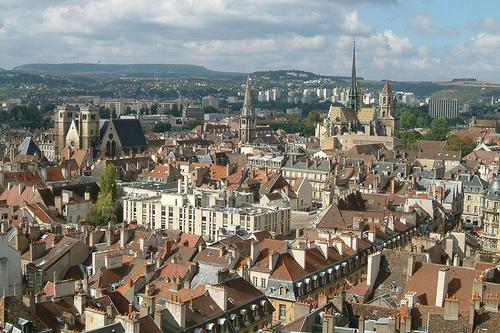 DijonPhoto:Christophe Finot CC 2.5 Unported no changes made
DijonPhoto:Christophe Finot CC 2.5 Unported no changes made
| advertisement |
| Hotels Dijon |
Location
The coordinates of Dijon are: 47° 17'26 'North latitude and 5° 02'34' East longitude.
The city is located in the eastern part of central France, 326 km southeast of Paris at the confluence of the Ouche and Suzon, and is 180 km from Lyon and 150 km from Lausanne in Switzerland. Dijon is situated at the foot of the hills of the Côte d'Or to the west and near a plain of fertile vineyards. The average height is between 220 and 410 meters. The area of Dijon is 40.41 km².
Burgundy is a region known for its vineyards and Burgundy wines. It consists of the central regions of Côte-d'Or, Saône-et-Loire, Nièvre and Yonne. This region is connected to the Paris Basin by the Saône River. To the northwest, the rolling lowlands of the Paris Basin gradually merge into Jurassic plateaus dating back some 200 million years.
Weather
The area surrounding Dijon has a moderate continental climate with hot summers and moderately cold winters. Spring and autumn are quite pleasant and a particularly good time to visit this interesting city. The average daytime temperature per year is 14.83 °C . The average nighttime temperature per year is 6.27 °C. Annual rainfall is 732.2 mm and the sun shines for about 1,800 hours a year.
History
Dijon is the historic capital of the Burgundy region. The city was chosen as the capital of the newly founded Duchy by Robert I, Duke of Burgundy, in 1015. During the reign of the Valois (1364-1477) the city flourished. Musicians, artists and architects were attracted to the patronage of the ducal court.
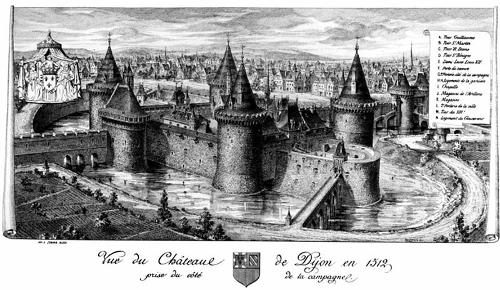 Castle of Dijon in 1512Photo: Arnaud 25 CC 3.0 Unported no changes made
Castle of Dijon in 1512Photo: Arnaud 25 CC 3.0 Unported no changes made
The city retained its important role as provincial capital after the Duchy of Burgundy was annexed by Louis XI of France in 1477. The city has been a diocese since 1731. In the 18th century, Dijon was very prosperous and became an intellectual center of France. After the French Revolution Dijon lost influence and the provincial institutions became less and less important. But the arrival of the railways in 1851 brought new wealth and caused population growth.
Today the city has a varied industrial production. Foods, pharmaceuticals, electronics, electrical equipment, auto parts, plastics and optical instruments are the main products. Famous Dijon foods are mustard, vinegar and gingerbread.
Sights
Various architectural styles from different periods of the last millennium can be seen in Dijon. There are many buildings in the central part of the city that date back to the 18th century and many other buildings from the Gothic and Renaissance times. The burgundy multicolored roofs made of green, yellow and black with glazed terracotta tiles and eye-catching geometric patterns are characteristic of the original architecture of the city. Many of the old buildings date from the 12th to the 15th century. There are well-preserved picturesque half-timbered houses. Dijon suffered relatively little from devastation during the past wars.
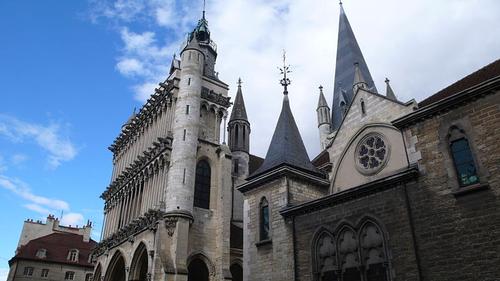 Notre Dame de DijonPhoto: Welleschik CC 3.0 Unporte no changes made
Notre Dame de DijonPhoto: Welleschik CC 3.0 Unporte no changes made
Dijon has a large number of churches, such as Notre Dame de Dijon. The Church of Notre Dame is known for both art and architecture. Popular legend has it that one of the stone sculptures (an owl) brings happiness to the visitors of the church. When they touch the owl with their left hand they can make a wish. Other important churches are: St. Philibert, St. Michel and Dijon Cathedral. There is a thousand-year-old crypt dedicated to Saint Benign.
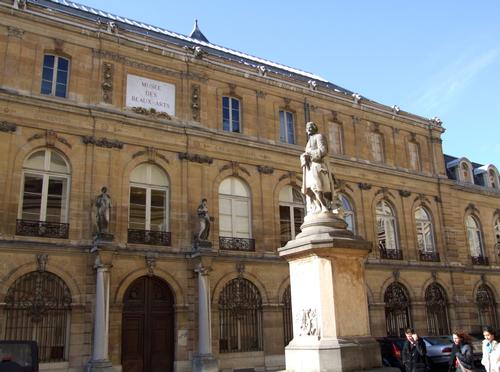 Dijon Musee des Beaux-ArtsPhoto: Christophe Finot CC 2.5 Generic no changes made
Dijon Musee des Beaux-ArtsPhoto: Christophe Finot CC 2.5 Generic no changes made
Dijon has many museums, including the Musee des Beaux-Arts de Dijon, which is housed in part of the Ducal Palace. It includes, among other things, the ducal kitchens dating back to the mid-15th century and a significant collection of European art from Roman times to contemporary art. The original medieval palace was largely rebuilt and expanded in the 17th and 18th centuries. The two towers of the 14th and 15th centuries have been preserved. The palace is now the Hôtel de Ville (town hall) and the Musee des Beaux Arts (Museum of Fine Arts). The beautiful tombs of Philip the Bold (1342-1404) and John the Fearless (1371-1419), dukes of Burgundy, can be seen here.
Tips
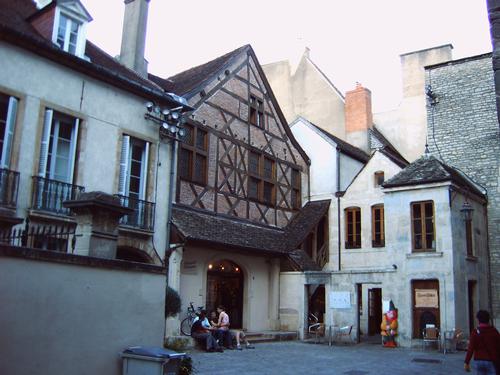 Dijon Rue de la ChouettePhoto: David Monniaux CC 3.0 Unported no changes made
Dijon Rue de la ChouettePhoto: David Monniaux CC 3.0 Unported no changes made
The very interesting neighborhood Jean Jacques Rousseau is located behind Notre Dame. Antique shops, galleries and specialty shops make this area the avant-garde place of the city. It is a must to visit the Maison Millière, one of the oldest medieval buildings on Rue de la Chouette. This building has now been transformed into a tearoom with a beautiful garden terrace. There are French boutiques on Rue de la Liberty
Useful links Dijon
BBC Country ProfilesWorld Fact Book Explore all Countries
How to call
Last updated September 2024
Copyright: Team - The World of Info